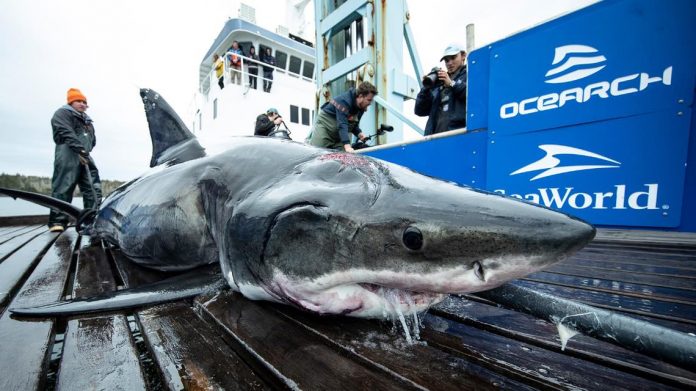A heavily scarred 1,164-pound great white shark captured in the North Atlantic has researchers pondering a chilling question: What would bite the head of 12-foot-9-inch apex predator?
Their best guess is an even bigger shark — a much bigger shark.
“It was clear that something had just grabbed his entire head,” OCEARCH Founding Chairman Chris Fischer told McClatchy news group.
“There was one healed wound on the lower jaw, perhaps from a previous year’s bite. And another that was over and across the top of his head. It was a very large animal that grabbed it, something significantly bigger than 12 feet.
“Anything that can grab an animal like that by the head is pretty impressive,” he said.
Pressed for a guess, Fischer said the teeth marks and jaw size suggest the attacker was 2 or more feet longer than its victim.
Turns out one such monster was nearly caught by OCEARCH researchers in the same area this month, he said: a 17-foot male great white that escaped before a tracker could be attached.
Had OCEARCH succeeded, the shark would have been the largest ever tagged in the Northeast Atlantic by the agency. OCEARCH, a nonprofit, has tagged more than 400 animals in the past 12 years, resulting data that shows sharks use the East Coast as a highway from Nova Scotia to the Caribbean and Gulf of Mexico.
As for the heavily scarred shark, it was caught Oct. 4 during an expedition to tag white sharks off Nova Scotia for satellite tracking. It was named it Vimy, and tracking shows it has since traveled more than 600 miles south to the coast off Maryland.
Fischer has two guesses about why it might have been bitten: Vimy was either competing with other males for a female and lost, or he tried mating with a larger female who bit him.
It’s also possible he got in the way of a larger shark eating a seal, but Fischer said he thinks that is less likely.
The fact that Vimy’s bite wound was less than a week old is considered an important clue, Fischer said. Researchers are trying to find out where white sharks are mating in the North Atlantic, and a fresh bite on a large shark indicates they may have found it.
“We found three males in that same spot and the two others had viable sperm samples. Maybe Vimy was just the small guy on the block,” Fischer said. “We do know that shark mating is very violent. Sharks biting each other in the head is not a new thing. This is an every day part of their life.”
While that sounds disturbing, he noted that sharks “have a rapid capacity to heal,” suggesting Vimy was not in a lot of pain.





























